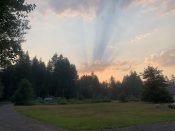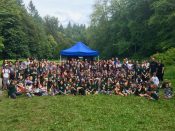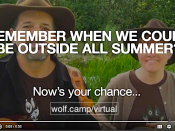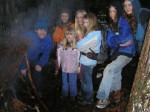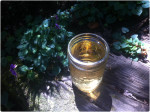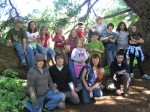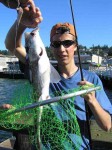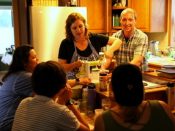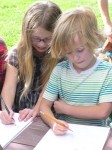In Bellingham on Tuesday, it was a cold, snowy day! After some quick introductions, a few exercises to help us stay warm and a fictitious emergency scenario in front of Village Books we walked over to Padden Creek Trail to continue class. Each family was given a packet of emergency preparedness and survival handouts to take home to read and discuss. Then we talked about several suggestions for preparing our homes and selves for the unexpected. In Olympia, we met on the Evergreen State College campus and spent most of the time in the woods near the library. In Vancouver, we discussed emergency preparedness in the Community Center before heading out to explore the grounds for shelter-making materials, wild edibles and to learn how to make fire.
After heading outside at each of the locations, we spent a few minutes talking about what to do (and what not to do!) if you get lost in the woods. Skye did a couple of demonstrations (many thanks to our volunteers!) to show everyone how a search dog works when looking for lost people.
Chris taught everyone about the Critical Order of Survival. We began by learning the importance of breathing and how it can even help to warm you up a bit! Then everyone tried to see how long they could hold their breath. Chris won out at 1 minute 9 seconds. It’s really hard to do unless you practice.
Everyone is practicing deep breathing.
We walked down the trails, through the woods and around the grounds at the various locations looking for places that might provide natural shelter. We learned about the 5 W’s (wood, wind/weather, water, widow-makers and wigglies) and their importance in selecting a safe place to stay.
Chris is teaching the Bellingham group how to tell if branches are dead and good for building a fire.
Making a wooden frame for a stuffed animal sized debris hut.
Gathering leaves to use for warmth inside the debris hut.
The Vancouver group tests to see if the debris is think enough to keep Skye’s giraffe dry in a “torrential downpour”.
Depending on the location, students chose a site and spent a few minutes gathering supplies from the surrounding area to make a teepee fire and/or shelter. Chris evaluated everyone’s sites and fires and offered suggestions.
Western redcedar offers excellent protection from the elements and provides wood for fire, shelter, tools, clothing and so much more.
The Olympia homeschool group used wood they found nearby as the shelter roof then lined and weatherproofed the sides with strips of bark from an old stump.
We talked about using water in a survival situation and how to sterilize it by rock boiling if you don’t have some sort of pot or kettle available. Then Chris demonstrated how to make fire by friction using a bow drill. Finally we continued on the trail and discussed the importance of food and some of the native plants that could be used as wild edibles if needed.
Chris shows the group a burn bowl and shares how to make one.
The kids learn how to make tinder from cedar.
Chris demonstrates how to make a fire using a bow drill.
Skye looks on as Chris demonstrates fire by friction.
The Olympia group built a lean-to to protect their fire and reflect it’s heat.
Chris and the group are sampling blackberry pith as a wild edible. It’s not as tasty as ice cream but it (among other things) will help get you through.
The topics we discussed are so vitally important and there is so much information to share that we were only able to provide the briefest of summaries in our two hours together. Our hope is that with this overview of the basics each family will be able to assess their level of preparedness and work to fill in the gaps so they’ll be ready should the need arise.


